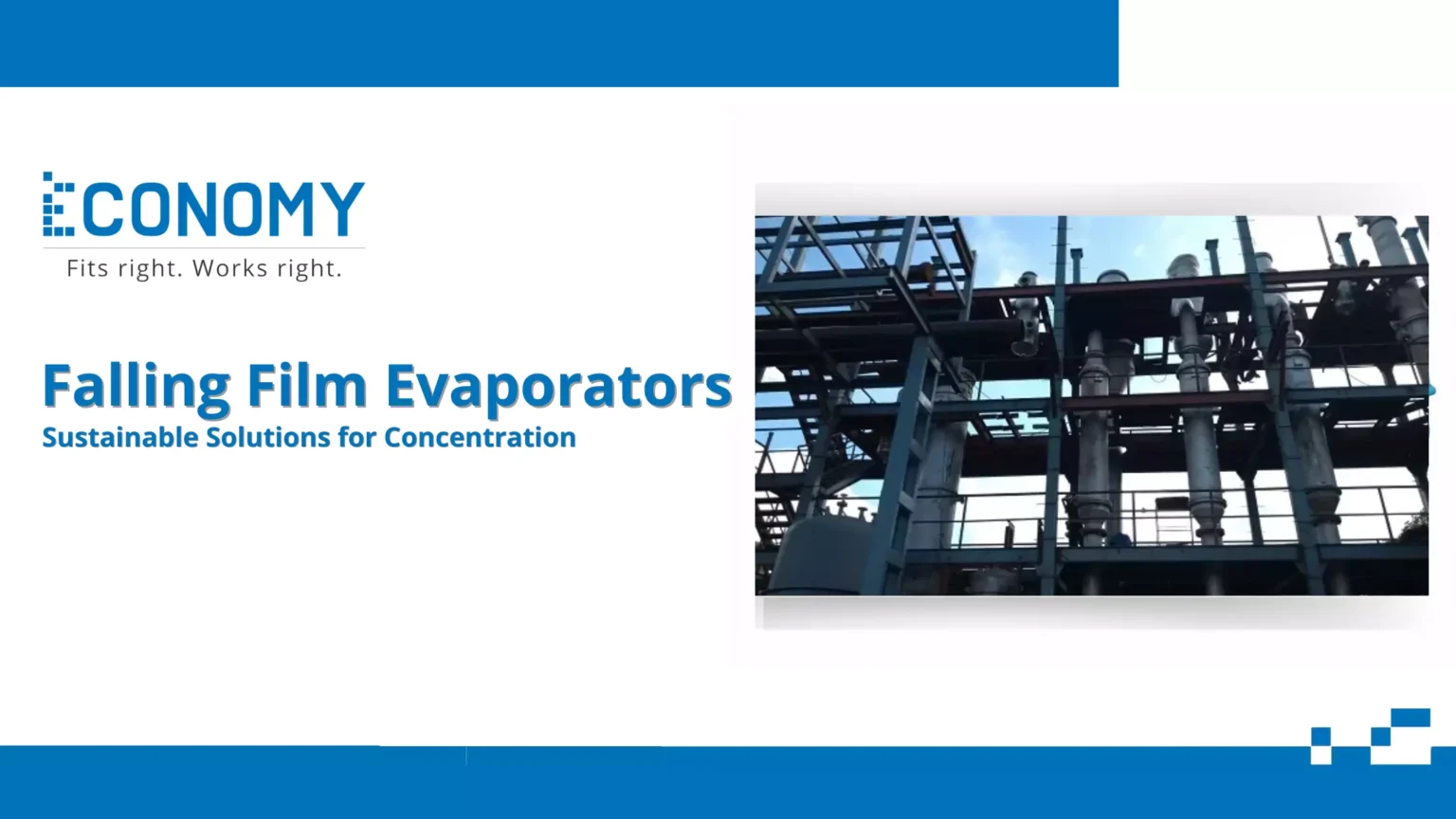The Basics of Falling Film Evaporators
Falling film evaporators are advanced heat exchange systems widely used in industries for concentrating solutions, particularly when dealing with heat-sensitive materials. These evaporators operate by spreading a thin film of liquid over a heated surface, which encourages rapid evaporation. The process is efficient and gentle, making falling film evaporators particularly suited to processes in industries such as food and beverages, pharmaceuticals, chemicals, and wastewater treatment.
In a falling film evaporator, liquid flows downward along the inner surface of tubes or plates, where it is heated indirectly. As the liquid descends, it evaporates, separating into vapor and concentrated solution. The system’s ability to handle high evaporation rates with low energy consumption, while preserving product quality, positions it as a sustainable solution for concentration.
How Falling Film Evaporators Work
Falling film evaporators rely on gravity and controlled heat transfer to evaporate liquids. The process begins when the liquid feed enters the evaporator at the top of a vertical heating surface, typically composed of tubes or plates. The liquid is evenly distributed across the surface, forming a thin film that flows downward under the influence of gravity. As the film of liquid travels along the heated surface, heat is transferred from the heating medium (often steam) to the liquid, causing the volatile components to vaporize.
The liquid film ensures that the heat is rapidly and uniformly distributed, leading to efficient evaporation. Vapors generated during this process are collected and either condensed or further processed, while the concentrated solution continues downward, exiting the evaporator at the bottom. The separation of vapor and liquid occurs within the same unit, eliminating the need for complex equipment or external mechanisms.
One of the key advantages of this system is that the liquid remains in contact with the heating surface for only a short time. This minimizes the risk of thermal degradation, which is particularly important for heat-sensitive products like dairy, juices, and pharmaceuticals. Additionally, the thin film improves heat transfer efficiency, allowing for lower operating temperatures and reducing energy consumption.
Design Features of Falling Film Evaporators
Falling film evaporators are designed with several key Features of Falling Film Evaporators that enhance their efficiency and adaptability:
- Heat Transfer Surfaces: The evaporator typically features a bundle of vertical tubes or plates where heat exchange occurs. These surfaces are designed to maximize the surface area available for heat transfer, ensuring efficient evaporation.
- Film Distribution System: A critical component of the design is the distribution system that evenly spreads the liquid feed over the surface. This prevents dry patches, which can reduce efficiency and increase the risk of fouling.
- Multiple Effects: Many falling film evaporators are designed with multiple effects, where the vapor generated from one stage is used to heat the subsequent stage. This reduces overall energy consumption, making the system more sustainable and cost-effective.
- Low-Temperature Operation: Because the evaporators operate with a thin film of liquid and efficient heat transfer, they can function at lower temperatures. This is particularly important for processing sensitive materials that could be damaged by high heat.
- Corrosion-Resistant Materials: Given the wide range of applications, falling film evaporators are often constructed from materials like stainless steel or specialized alloys that can withstand corrosive environments, such as in chemical processing.
Operating Advantages of Falling Film Evaporators
The operating advantages of falling film evaporators make them a preferred choice for industries looking to enhance efficiency and reduce environmental impact:
- Energy Efficiency: The thin film design ensures quick and uniform heat transfer, reducing the energy required for evaporation. In multi-effect configurations, energy use is further minimized by recycling heat from previous stages.
- Low Thermal Stress: The short residence time of liquids on the heating surface prevents thermal degradation, making these evaporators ideal for products that are heat-sensitive. This characteristic extends the range of materials that can be processed without compromising quality.
- Flexibility: Falling film evaporators can handle a wide range of feed viscosities and concentrations. This versatility allows them to be applied in diverse industries, from dairy processing to chemical manufacturing.
- Scalability: The modular nature of these systems allows for easy scaling, whether an operation needs a small, single-effect system or a large, multi-effect setup. This scalability makes them ideal for both pilot plants and large-scale industrial operations.
- Low Maintenance: Falling film evaporators are relatively easy to clean and maintain. The design minimizes fouling due to the thin film and consistent flow of the liquid, reducing downtime and operating costs.
Applications of Falling Film Evaporators
Falling film evaporators are used in various industries where concentration, purification, or solvent recovery is required:
- Food and Beverage Industry: These evaporators are extensively used for concentrating dairy products like milk and whey, as well as fruit juices and sweeteners. The ability to operate at low temperatures ensures that flavors, nutrients, and other important qualities are retained.
- Pharmaceuticals: In the pharmaceutical industry, falling film evaporators are employed for concentrating active ingredients and recovering solvents. The low-temperature operation ensures that the delicate chemical compositions of drugs remain intact.
- Chemical Processing: For chemical manufacturing, these evaporators are used to concentrate and purify chemical solutions, as well as recover solvents for reuse. The ability to handle corrosive materials makes them particularly suited for this sector.
- Wastewater Treatment: Falling film evaporators are increasingly being used for treating industrial wastewater, helping to concentrate and remove harmful substances. This application aligns with global sustainability efforts by reducing waste and recycling water.
Conclusion
Falling film evaporators represent a sustainable, efficient, and versatile solution for concentration across a wide array of industries. Their energy efficiency, adaptability to heat-sensitive materials, and low maintenance requirements make them an increasingly popular choice in modern manufacturing and environmental management. As industries continue to seek more sustainable processing solutions, falling film evaporators stand out as a reliable technology that meets the demands of both product quality and environmental responsibility.






